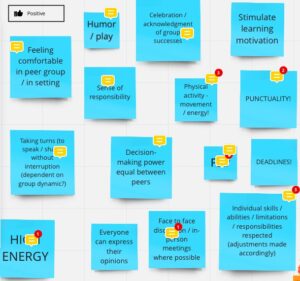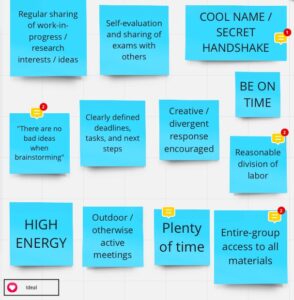Establish our peer group as our Basho:
While the phrase Basho 場所 is used widely in Japanese culture, the particular concept – “logic of place” – was developed by Nishida Kitaro – founder of the Kyoto School of Philosophy in 1926. We will be drawing loosely on the theory of Basho as refracted through the lens of SECI organisational learning theory rather than Nishida and the Kyoto School specifically.
‘On the one hand, the environment influences agents, and on the other hand, the agents are continuously recreating their environment through social interaction. Hence, social structure does not exist independently outside of human agency. Rather, structure and humans are two ways of considering social action and they interplay in defining and reproducing each other.’ (Nonaka and Takeuchi 2003: 4).
Blue Basho built our Basho Covenant on the morning of September 23rd, 2021. Usually, the places where we study are built for us. Classrooms and studios are set up by our teachers, while architects and construction companies build our buildings. However, art students rarely have the opportunity to create their own studio space and how to split the learning space between them. I was surprised to find that at ECA, the professor had set up an experimental learning space, which university students designed at the university and art college. I was fascinated that this approach broke with traditional forms of course design, and I wanted to venture out with my group to try our own Basho.
Are learners less likely to engage with learning when they don’t help construct their learning place? So we were a bit scared to try it. Also, if learners don’t have a say in constructing their own place of learning, do they have less control over how or what they learn, which is a break from the traditional teaching model. I did my best to keep my fluctuating emotions in check, and we followed the ‘Nishida philosophy’, where the subject and the environment are interconnected, and then learners had to construct their own learning place as part of our learning programme this makes our group proud.
I think the main reason why Basho Covenant works well is because the whiteboard is used to outline your own personal Covenant, and that people are related to their environment, and we are given four quadrants (top left quadrant (A) with positive environmental and social attributes, top right quadrant (B) with negative environmental and social attributes, bottom left quadrant (C) with the ideal environment and social behaviour and (D) forbidden environmental attributes and social behaviour) in the lower right quadrant. Furthermore, the art world is not a single, homogeneous, hermetically sealed social group; from Nishida’s perspective, the art world is a large, somewhat amorphous basho made up of a series of the smaller basho. We are placed within it, and new, smaller, atomised art worlds are constantly being born while others are dying out. The artworld is therefore akin to a fermenting culture, it is akin to the constant cycle of life.
I think there are two things I can take away from this. On the one hand, we construct Basho Covenant, where we hold each other accountable, with clear responsibilities, oversight and missions. On the other hand, our places of learning are both physical and conceptual – places of learning are constructive parameters that help us construct ideas and actions.
Creating our Basho’s covenant: Positive / Negative / Prohibited / Ideal




https://miro.com/app/board/o9J_lvbYV10=/


Leave a Reply